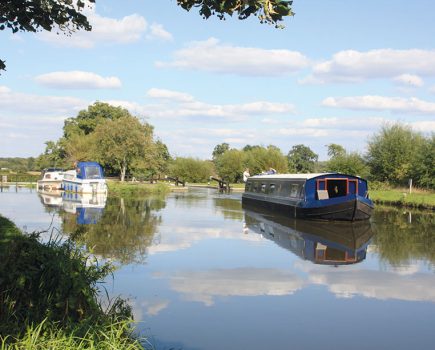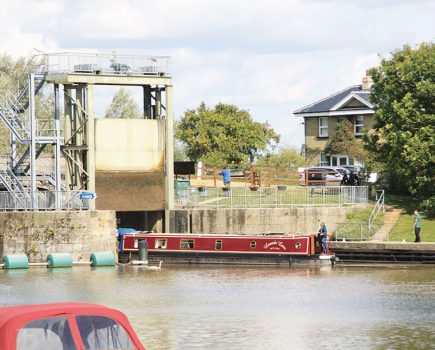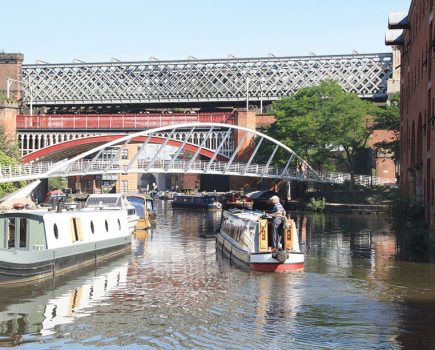Fitting a solar set up is quite often a winter, or early spring, project after a summer of thinking ‘I wish we had solar panels…’, so here’s a guide to help if you’re thinking along those lines

Words: Martin Judd, Director of Sales at Leading Edge Power
Providing solar power to a boat has become significantly more cost effective over the last few years as solar panel prices have fallen and the technology has become more mainstream.
Nowadays, solar panels are smaller and less obtrusive, the electronics are more reliable and nearly everything can be fitted by anyone with only basic DIY skills. Essentially, boat solar systems are designed to work alongside any mains hook-up that you may use while moored, plus they give you the freedom to moor anywhere and enjoy the peace and quiet without the drone of an engine or generator to keep the batteries charged.
A basic system has three components: solar panel(s), charge controller and batteries. The photovoltaic solar cells in the panel produce electricity, the controller regulates it, just as a mains charger would, and the batteries store the power for later. Typically, a battery (or bank of batteries) is 12v, although 24v systems are becoming more popular.
Calculating power usage

The size of your solar system depends on what you want it to do. There is no limit to what you can achieve apart from size and budget. You should first do a power audit, listing all of the electrical devices you use regularly, their power consumption in watts (W) and how long they are used during any given 24-hour period.
For complete autonomy (ie. not having to top up the system with power from a generator), you need a system that will replace this energy each and every day. In reality, many people find they actually use less power after installing solar panels, mainly because they are more aware of where the electricity is coming from. So you can try installing a system that is slightly smaller than you calculate at first, but if you do that, make sure the charge controller is large enough to accommodate an extra panel or two in case you want it later.
Choosing the right panels
Solar panels produce different amounts of power depending on the type of solar cells they use and the quality of construction. There are two types of solar cells available: polycrystalline and monocrystalline.

Polycrystalline has a blue colour, whereas the monocrystalline cells are almost black. Monocrystalline cells are more efficient and tend to be able to produce more power in low or variable light conditions. The higher the efficiency, the better, as this is a sign of a good quality cell and results in a smaller, more compact solar panel.
There is no easy way to tell the efficiency of a solar cell, unless the manufacturer declares it on their datasheet (a reputable company always will). However, just looking at the size of the panel can be quite telling. For example, the smallest, most efficient 100W solar panels are about 1.0m x 0.5m, whereas the cheapest, least efficient 100W solar panels might be 1.2m x 0.8m in size.
In terms of area, the cheapest may well be 90 per cent larger and where space is restricted on the roof of a boat, this severely limits your options. In terms of power production, a single 100W ultra-high efficiency panel using monocrystalline cells, for example, will produce 600-750Wh a day in summer, whereas a cheap 100W polycrystalline panel might only be 500-600Wh.
This difference is even more marked when the sky is overcast. Sunpower solar cells with 21.5 per cent efficiency will produce up to twice as much power on an overcast day as a standard B-grade polycrystalline panel.
As a rule of thumb, to achieve year-round performance, you can estimate the daily output of a panel at 70 per cent maximum for five hours a day, so 100W x 0.7 x 5 = 350Wh a day.

Using the above example with a 912Wh daily load, 300-400W of panels would be ideal.
Monocrystalline panels are available with rigid aluminium frames and also, more recently, as flexible laminated panels weighing significantly less. Good quality glass-fronted panels will be fitted with 3.2mm or 4.0mm toughened glass and a 35mm or 46mm aluminium frame.
Which controller?
Now you need to select the right solar charge controller and size it for your installation.

The two main types are PWM (Pulse Width Modulation) and MPPT (Maximum Power Point Tracking). Until quite recently, good quality MPPT controllers were very expensive, but prices are coming down quite quickly. Some start at less than £100, so most solar systems are now using MPPT technology.
With PWM controllers, some power is lost as the voltage is reduced from, typically, 17v from the panel, to 14v for charging the batteries. In 95 per cent of cases this is absolutely fine because the cost of these controllers is much lower.
An MPPT controller allows the voltage of the panels and the batteries to be independent (so long as battery voltage is less than panel voltage). In a normal installation, using a typical 17v panel, you can expect 10-15per cent more charge current from an MPPT controller. With panels that have much higher voltages, MPPT controllers are essential.
You can also choose controllers with built-in displays, remote panels or even the ability to split the charge (eg, 10 per cent to the starter battery and 90 per cent to the leisure batteries). The size of the controller is declared in amps (A). Each panel has a ‘short circuit current’ value and these should be added together to select the controller.
The 100W DC Solar panel for example has a short circuit current of 5.92A so four panels require a controller of 24 amps or more. Fitting a controller that has additional capacity allows you to fit more panels later.
Batteries
The final part of the equation is batteries. As a general rule, the size of your battery(ies) should allow two days without any solar input, without going below 50 per cent state of charge.
Using our example of 912Wh, that suggests about 300Ah of batteries (3 x 100Ah connected together in ‘parallel’). The calculation:
Wh ÷ 0.5 x [number of desired days of autonomy] ÷ voltage
(912 ÷ 0.5 x 2 ÷ 12 = 304Ah)
As always, never use standard car batteries for your leisure bank. Only ever use deep cycle ones, and when it comes to battery storage capacity, you can never have too much.
There are however, a few important tips to consider when maintaining a healthy battery bank and get the longest lifetime:
1) When connecting batteries in parallel (ie, positive to positive, negative to negative), never use more than six in a string, otherwise you will struggle to keep the batteries balanced
2) Make sure that all battery-to-battery cables are the same thickness and length and are as straight as possible; this helps keep the balance
3) Never mix batteries of different sizes, makes or significantly different ages
4) Always double check that the optimum charging voltages for your specific battery type are compatible with the charge settings of the solar charge controller
5) Use an accurate battery monitor so that you have as much information as possible about the state of your bank
6) Always connect to the batteries on a negative terminal at one end of the bank and a positive at the other end; never connect to positive and negative terminals at one end of the bank, as this will effectively kill the batteries very quickly
Powering on-board electrics
To add 240v you need an inverter, which connects directly to the batteries. This can be either ‘pure/true’ sine wave, or ‘modified’ sine wave. Pure sine wave inverters are much more efficient and will operate any device. There are some limitations to modified sine wave inverters, although they are a lot cheaper.
One of the most important things to bear in mind when considering solar power is that you tend to get what you pay for. That does not mean paying over the odds, but the industry has matured to the point where products cannot simply be sold cheaper – they can only be made more cheaply and sold for less.
_________________________________
Boats reviewed with solar panels:
The Boat Test: Research Project
Boat Test: Standard Narrowboats 57ft
Image(s) provided by:
Archant







